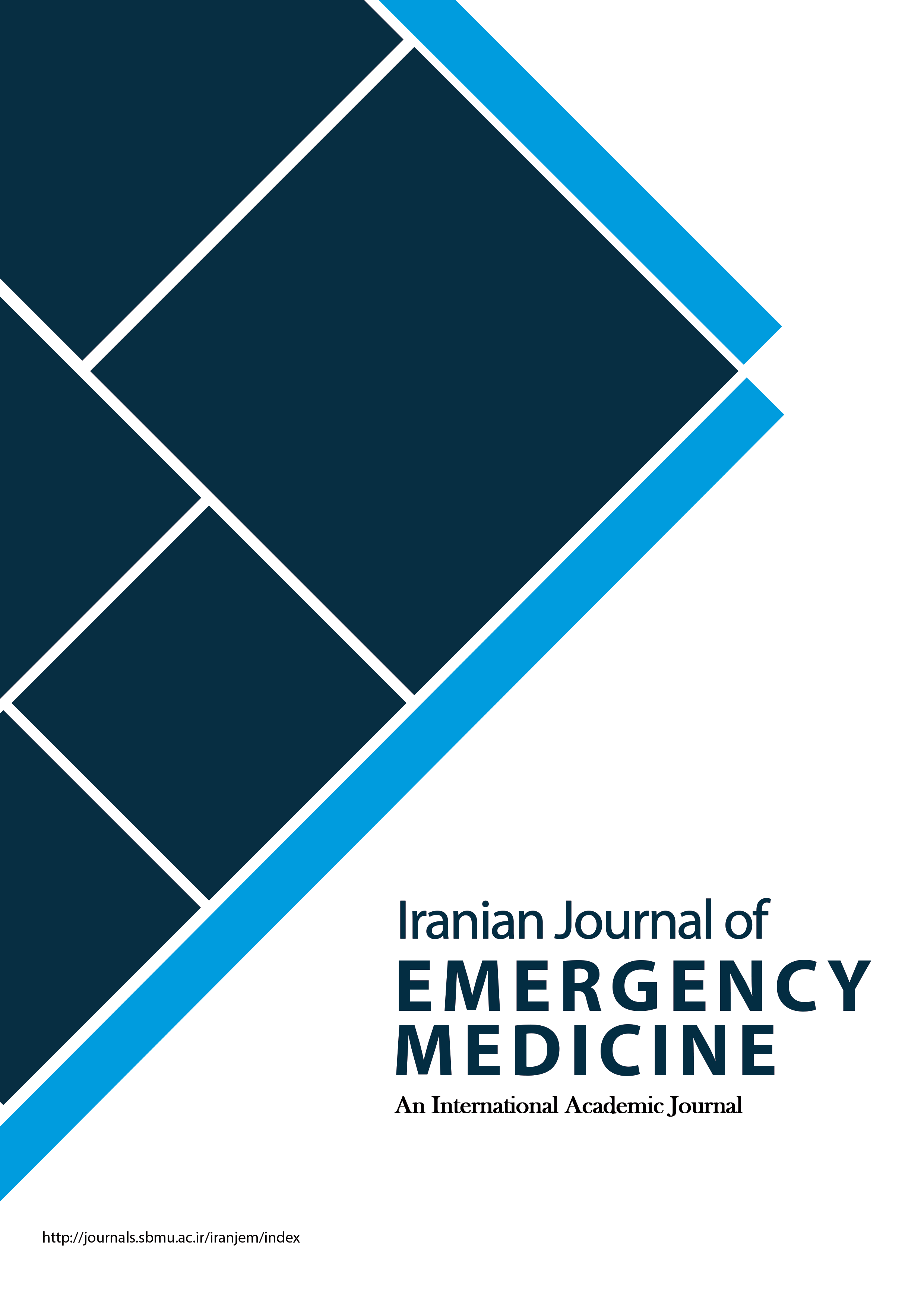Knowledge and Practice of medical Interns Regarding Use of Neck Collar in Trauma Patients; a Cross-Sectional Study
Iranian Journal of Emergency Medicine,
Vol. 5 No. 1 (2018),
8 February 2018
,
Page e11
https://doi.org/10.22037/ijem.v2i1.19433
Abstract
Introduction: Having the skill for choosing the proper collar and correctly fastening it is very important for preventing neurovascular injuries in patients with head and neck trauma. Therefore, the present study was designed and carried out with the aim of evaluating the knowledge and practice of medical interns regarding use of neck collar for trauma patients. Methods: In this cross-sectional study, the knowledge and practice of medical interns who were admitted to the medical internship program of Guilan University of Medical Sciences in 2009 was assessed in winter of 2017 using a questionnaire, the validity and reliability of which had been approved. Results: 80 medical interns with the mean age of 25.93 ± 1.02 years were studied (76.2% female). Mean knowledge score of the participants was 11.5 ± 2.7 (3 to 19). In addition, their mean practice score was 16.5 ± 2.3 (10 to 20). The highest rate of lack of knowledge was observed regarding factors predicting the rate of damage to neck and spinal cord (98.8%), the importance of injury (95.0%), the maximum time allowed for using neck collar (91.3%) and incorrect measures (91.3%). In addition, the highest rate of error in practice also belonged to leveling external auditory meatus with shoulder after fastening the neck collar in children (98.8%), putting a protective pad behind the rib cage after fastening the collar in children (95%) and employing at least 3 people when fastening the collar and maintaining the immobility of the vertebra before fastening the collar (65.0%), respectively. The score of practice and knowledge had a reversed correlation (p = 0.023, r = -0.225). Conclusion: Based on the findings, the rate of knowledge regarding neck collar usage in more than 70% of the medical interns in the present study was in the intermediate to poor range. In addition, the practice of 60% of them was in the intermediate to poor range. There was no direct correlation between the knowledge and practice of the students in this regard.How to Cite
References
ATLS S, group IAw. Advanced trauma life support (ATLS®): the ninth edition. The journal of trauma and acute care surgery. 2013;74(5):1363.
Allen B, Ganti L, Desai B. Trauma and ATLS. Quick Hits in Emergency Medicine: Springer; 2013. p. 37-45.
Crocker M, Haliasos N, Rennie A, Saxena A. Blunt traumatic vertebral artery injury: a clinical review. European Spine Journal. 2011;20(9):1405-16.
Khanna P, Chau C, Dublin A, Kim K, Wisner D. The value of cervical magnetic resonance imaging in the evaluation of the obtunded or comatose patient with cervical trauma, no other abnormal neurological findings, and a normal cervical computed tomography. Journal of Trauma and Acute Care Surgery. 2012;72(3):699-702.
Asadi P, Asadi K, Monsef-Kasmaei V, Zohrevandi B, Kazemnejad-leili E, Kouchakinejad Eramsadati L, et al. Evaluation of Frequency of Cervical Spine Injuries in Patients with Blunt Trauma. Journal of Guilan University of Medical Sciences. 2015;23(92):31-6.
Watanabe M, Sakai D, Yamamoto Y, Sato M, Mochida J. Upper cervical spine injuries: age-specific clinical features. Journal of Orthopaedic Science. 2010;15(4):485-92.
Bromberg WJ, Collier BC, Diebel LN, Dwyer KM, Holevar MR, Jacobs DG, et al. Blunt cerebrovascular injury practice management guidelines: the Eastern Association for the Surgery of Trauma. Journal of Trauma and Acute Care Surgery. 2010;68(2):471-7.
Molinari RW, Khera OA, Gruhn WL, McAssey RW. Rigid cervical collar treatment for geriatric type II odontoid fractures. European Spine Journal. 2012;21(5):855-62.
Thorgilsdottir T, Ingimundarson AT, Einarsson P. Cervical collar having height and circumferential adjustment. Google Patents; 2011.
Voss S, Page M, Benger J. Methods for evaluating cervical range of motion in trauma settings. Scandinavian journal of trauma, resuscitation and emergency medicine. 2012;20(1):50.
Lemyze M, Palud A, Favory R, Mathieu D. Unintentional strangulation by a cervical collar after attempted suicide by hanging. Emergency medicine journal. 2011;28(6):532-.
Horodyski M, DiPaola CP, Conrad BP, Rechtine GR. Cervical collars are insufficient for immobilizing an unstable cervical spine injury. The Journal of emergency medicine. 2011;41(5):513-9.
Kreinest M, Goller S, Rauch G, Frank C, Gliwitzky B, Wölfl CG, et al. Application of cervical collars–an analysis of practical skills of professional emergency medical care providers. PloS one. 2015;10(11):e0143409.
Sundstrøm T, Asbjørnsen H, Habiba S, Sunde GA, Wester K. Prehospital use of cervical collars in trauma patients: a critical review. Journal of neurotrauma. 2014;31(6):531-40.
Bozzo A, Marcoux J, Radhakrishna M, Pelletier J, Goulet B. The role of magnetic resonance imaging in the management of acute spinal cord injury. Journal of neurotrauma. 2011;28(8):1401-11.
Ahn H, Singh J, Nathens A, MacDonald RD, Travers A, Tallon J, et al. Pre-hospital care management of a potential spinal cord injured patient: a systematic review of the literature and evidence-based guidelines. Journal of neurotrauma. 2011;28(8):1341-61.
Frohna WJ. Emergency department evaluation and treatment of the neck and cervical spine injuries. Emergency medicine clinics of North America. 1999;17(4):739-91.
- Abstract Viewed: 757 times
- PDF (فارسی) Downloaded: 802 times
- HTML (فارسی) Downloaded: 72 times



